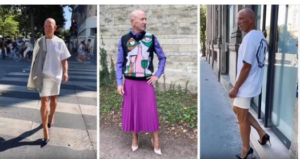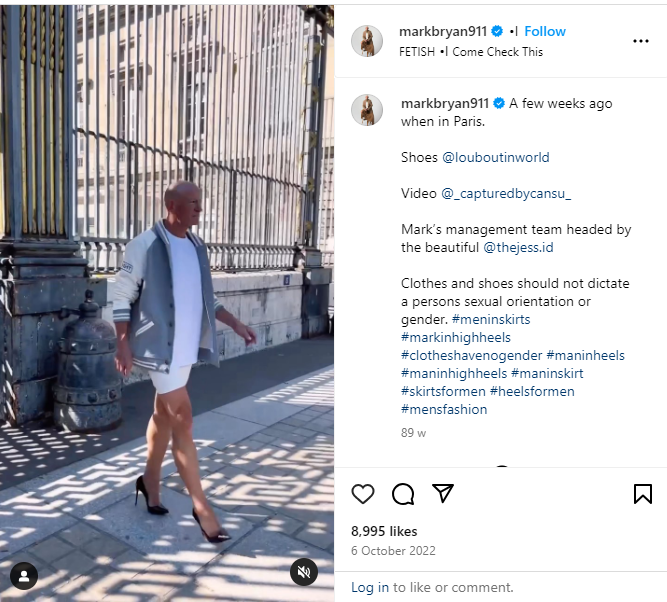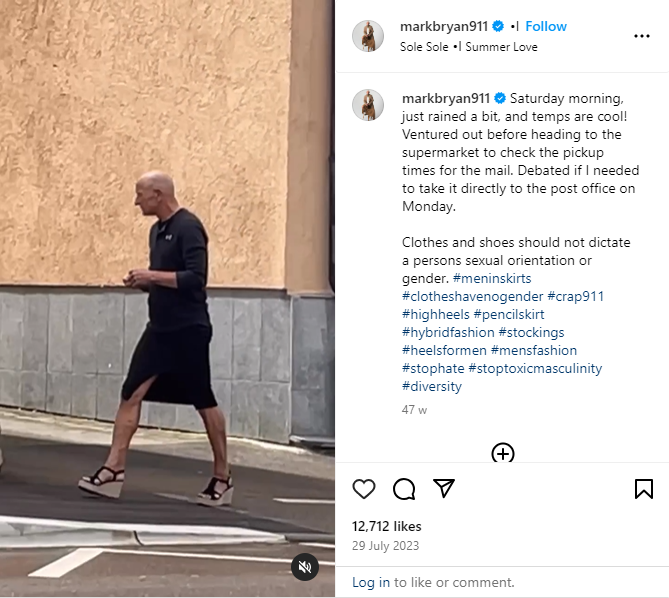
Mark Bryan is a robotics engineer who has been married for 11 years and has a daughter. He identifies as straight and chooses to dress unconventionally. Bryan is an American living in Germany, and he doesn’t believe that fashion has to be gendered. You can find Bryan wearing a skirt and heels to work or out anywhere else he goes on any given day.
Bryan said he doesn’t like how limited men’s choices are in the fashion department, especially when it comes to office attire. Men’s pants only come in a few colors, mostly black, gray, dark blue and the occasional pinstripe, and cuts.
The stylish dresser believes that if women are allowed to wear pants, men should be able to wear skirts and dresses as well. Bryan likes how skirts come in many styles and patterns – and many more colors – unlike men’s clothing.

Bryan prefers to mix traditional gender looks by wearing masculine attire on his top half, like a blazer and tie, and traditionally feminine attire on the bottom half. He will typically wear a pencil skirt and four-inch heels on the bottom.
Wearing high heels is no problem for Bryan. He first learned how to do it when his college girlfriend asked him to wear high heels while dancing with her so that they were on the same level. They continued this for over a year.
Bryan doesn’t let stereotypes or assumptions stop him from dressing in a way that brings him joy. He challenges expectations and does so unapologetically. Keep reading to hear what Bryan has to say about his fashion choices.
Bryan has a very clear idea about how he likes to dress. He told Bored Panda: “To me, clothes have no gender. I prefer skirts to dresses. Dresses don’t allow me to mix the genders. I prefer a ‘masculine’ look above the waist and a non-gendered look below the waist. It’s all about clothes having no gender.”
He continued: “I am old enough to remember that in school, the girls could not wear pants. Pants have now become a non-gendered article of clothing. So why can’t skirts and heels be non-gendered? Besides, men wore heels before women did. Maybe not today’s stiletto-style heels, but men did wear heels before women.”

Bryan is correct about that. High heels can look back on a long history. Although historians and archaeologists cannot date their invention clearly, they have been around at least since the 10th century. And they were not a fashion statement at first. No, the first recorded use of high heels was eminently practical: the Persian cavalry wore boots with heels, called a kalash or galesh, that made it easier for them to keep their feet inside their stirrups. This is, by the way, the same reason why cowboy boots have a small heel as well!
Since owning a horse was a sign of wealth, only well-off men could afford to wear these high-heeled boots. The use of them slowly spread across Europe, and high heels heels became one of the fashion signs of rich noblemen or traders. In fact, following the Great Schism of the Christian Church in the 11th century, even the pope wore high heels.
It wasn’t until several hundred years later that fashion slowly changed. During the 18th century, cultural concerns in Europe came up about the distinction between males and females and talk about what men and women should wear arose. This is the point in time where the belief that fashion is something effeminate and frivolous that “real men” shouldn’t care about hails from. Due to these changing beliefs, men largely abandoned high heels heels, as they were seen as impractical and mere accessories.

Bryan is one of the examples of how high-heels are slowly coming back as an accepted form of footwear for men. Although the engineer champions the option of wearing high-heeled shoes for men, he understands many people will look twice when they see him. He compares his style choices to someone who chooses to dye their hair bright colors. He explained:
“Take a person with bright green hair. Green hair is not normal. You look up and see this person, your mind tells you it’s a person with green hair, you think to yourself, that’s odd or interesting, then you go back to do what you were doing and don’t give it another thought. I believe this is the same when people see me in a skirt and heels.”
Bryan doesn’t have to struggle to find skirts and heels that fit him either. He wears a size 8 in skirts, and with smaller feet for a man, his shoe size in heels is 8.5. If you know a man who is considering trying out wearing heels and skirts too, Bryan suggests starting with a lower heel until you feel more comfortable walking in high heels.
What do you think of Mark Bryan’s style choices? Do you know any men who would try walking in high heels? Let us know, and be sure to send this along to your friends and family.
My Dad Went Fishing with His Buddies and Overlooked My 18th Birthday

Ryder’s 18th birthday should have been a memorable day, but his father’s absence left him feeling disappointed. Instead of celebrating with his son, his father chose to go on a fishing trip with friends, leaving Ryder devastated and questioning their relationship.
Growing up, Ryder’s life was normal until his parents started arguing when he was seven. By eight, his father was no longer living at home. Ryder vividly remembers his mother explaining the divorce, reassuring him that it wasn’t his fault. After the split, his mom worked hard as an elementary school teacher to provide for him, while his dad became more of a distant figure, often preoccupied with hobbies and weekends spent fishing.
As Ryder approached his 18th birthday, he hoped his father would finally prioritize him. He planned a small party with his mom and friends and even sent a message to his dad. When his father responded with: “I’ll try to be there”, Ryder felt a flicker of hope. However, on the big day, despite all the decorations and a cake baked by his mom, his father didn’t show up.
After waiting hours without any contact from his dad, Ryder called him, only to learn that he was still on the lake, seemingly indifferent to his son’s special day. Ryder felt crushed and hid in his room until his mom found him. He struggled to mask his disappointment, feeling invisible and unimportant.
A week later, his father called, offering to give Ryder a gift. Despite his anger, Ryder agreed to visit. When he arrived, his dad handed him a shiny fishing rod, a gift that felt more like a reminder of his absence than a thoughtful present. Ryder felt betrayed, realizing that his father would never truly prioritize him. When his dad invited him to join a fishing trip with friends, Ryder politely declined, knowing deep down that their relationship would never change.
As he left, holding the fishing rod, Ryder felt a shift within himself. He recognized he didn’t need to chase after someone who didn’t want to be there for him. In the months that followed, he focused on the people who truly cared—his mom and friends. He threw himself into music, practicing the guitar and helping his mom around the house to show his appreciation.
One evening, while washing dishes, his mom asked if he had heard from his father. Ryder shook his head, feeling at peace with his decision to stop waiting. His mom expressed sadness about their relationship, but Ryder reassured her that having her support was more than enough.
Over time, Ryder learned that his self-worth wasn’t dependent on his father’s attention. His experiences taught him an important lesson: sometimes, people won’t fulfill your expectations, and that’s okay. The fishing rod remains in his closet as a reminder not of what he lost, but of what he gained: self-respect, resilience, and the ability to move on from what he couldn’t change.



Leave a Reply